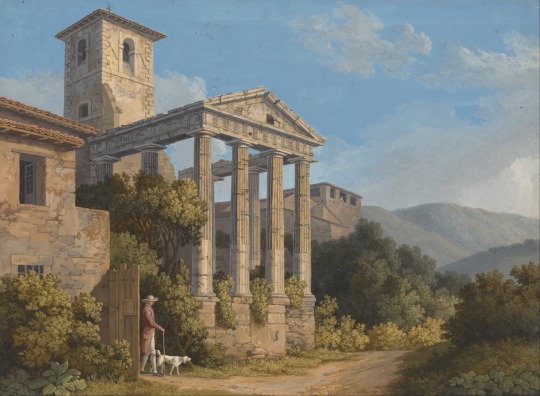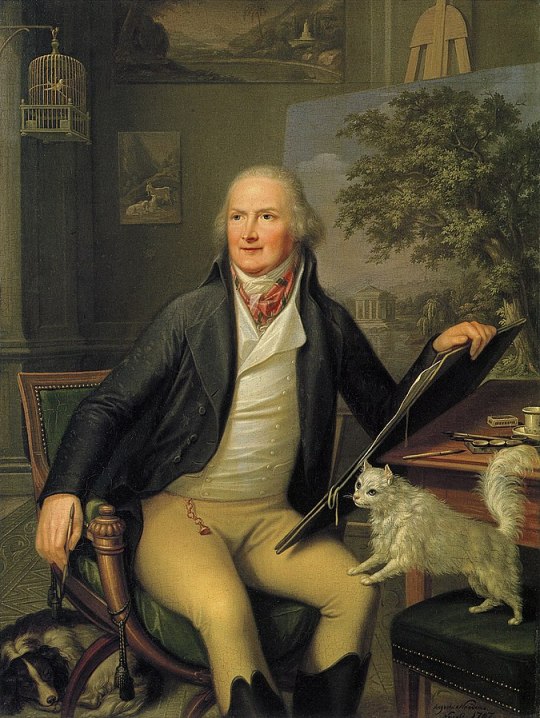#hackert
Text

Carl Ludwig Hackert (German, 1740-1796)
The Fountain Egeria near Rome, 1776
#Carl Ludwig Hackert#the fountain egeria near rome#1776#1700s#art#fine art#european art#classical art#europe#european#fine arts#oil painting#mediterranean#europa#italy#roman scene#roman landscape#landscape art#landscape#Capriccio#german art#german#germany
208 notes
·
View notes
Text

The Temple of Hercules in Cori near Velletri by Jacob Philipp Hackert
#temple#hercules#cori#velletri#art#jacob philipp hackert#romantic#landscape#italy#rome#lazio#italia#europe#european#temples#architecture#antiquity#architectural#nature#ruins#ancient
454 notes
·
View notes
Photo

Arkadische Landschaft von Jacob Philippe Hackert (1829, oil on canvas)
#kunst#kunstwerk#art#artwork#jacob philippe hackert#künstler#artist#landschaft#landscape#wiesen#meadows#felder#fields#bäum#trees#weideland#pastureland#animals#tiere#cattle#rind#vieh#aussicht#view#fluss#tempel#temple#fluss rifer#water#berg
9 notes
·
View notes
Text

Jacob Phillip Hackert, Fireworks at Castel Sant'Angelo in Rome, c. 1800
#jacob phillip hackert#Fireworks at Castel Sant'Angelo in Rome#1800s#romanticism#landscape#graphische sammlungen#paintings#art history#fine art
43 notes
·
View notes
Text

Fireworks at Castel Sant'Angelo in Rome
Jacob Philipp Hackert
1775
57 notes
·
View notes
Text

🇨🇭 🎨 View of Geneva from the Northwest with Mont Blanc - a coloured outline etching by Carl Ludwig Hackert (1740-1796). Digitally restored and enhanced.
#Europe#Switzerland#Swiss#vintage#art#Alps#landscape#Schweiz#Genf#Genève#Europa#Carl Ludwig Hackert#Geneva
2 notes
·
View notes
Text

Temple Ruins in Sicily
16 notes
·
View notes
Photo

The Waterfall at Tivoli, 1785 by Jacob Philippe Hackert
33 notes
·
View notes
Text

Jakob Philipp Hackert - Agrigento
24 notes
·
View notes
Photo

Augusto Nicodemo - Portrait of Jacob Philipp Hackert in His Studio, Naples - 1797
oil on canvas, height: 55.8 cm (21.9 in) Edit this at Wikidata; width: 42.1 cm (16.5 in)
Alte Nationalgalerie, institution Berlin State Museums, Germany
Jacob Philipp Hackert (15 September 1737 – 28 April 1807) was a landscape painter from Brandenburg, who did most of his work in Italy.
Hackert was born in 1737 in Prenzlau in the Margraviate of Brandenburg (now in Germany). He trained with his father Philipp (a portraitist and painter of animals) and his uncle, before going to the Prussian Academy of Arts in Berlin in 1758. Later he traveled to Swedish Pomerania and Stockholm, at the invitation of Adolf Friedrich von Olthof, a Swedish government official and businessman. For a time, he lived with Von Olthof and painted decorative murals at his estate.
He spent from 1765 to 1768 in Paris with the Swiss artist Balthasar Anton Dunker, where he focused on painting in gouache. He met and was inspired by Claude Joseph Vernet, who was already famous as a painter of landscapes and seascapes, and the German engraver Johann Georg Wille.
In 1768 Hackert left Paris with his brother Georg, and went to Italy, basing himself mainly in Rome and Naples, where he produced many works for Sir William Hamilton. He travelled all over Italy, gaining a reputation as a talented landscape painter. He became famous everywhere in Europe due to his works for Catherine the Great, the cycle of paintings about Battle of Chesma, and Pope Pius VI.
In 1786 he went to work for Ferdinand I of the Two Sicilies in Naples. He advised on the creation of a painting restoration laboratory at the Museo di Capodimonte, suggesting the call from Rome to the court of Naples of the restorer Federico Anders and supervised the transfer of the Farnese collections from Rome to Naples. As court painter realised famous pictures of Caserta and the Royal Palace of Caserta, besides the paintings series of the Bourobon's ports. During this period he acted also as a secret informant of Russia, his contact being the Russian diplomat Andrey Razumovsky.
When Goethe visited Naples in 1786, he and Hackert became friends.
Hackert had settled in a house in Posillipo. The painters Salvatore Fergola and Salvatore Giusti (1773-1845) were among his pupils.
In 1799, when Naples was declared the Parthenopaean Republic, Hackert lost much of his royal patronage. He moved to Pisa and then Florence. He bought an estate in San Pietro di Careggi, near Florence, and he died there in 1807 and was buried in the so-called "Dutch garden" of Livorno. His remains were then moved to the actual cemetery of the Dutch-German Congregation.
He never married and lived a good part of his life with one of his brothers but he had affairs with some married women, and from one of them he probably had a daughter.
Goethe wrote the first biography of Hackert in 1811.
15 notes
·
View notes
Text

1783, Jacob Philipp Hackert, Villa of Maecenas and the Waterfalls at Tivoli
#Jacob Philipp Hackert#Villa Maecenatis et cataracta Tivoliensis#saec. XVIII#1783#pictura#Galleria Nazionale d'Arte Moderna#Romae#Maecenas
7 notes
·
View notes
Text

#art#paintings#museum#art pieces#tumblr art#Carl Ludwig Hackert — The Aqueducts at Caserta (1789) [3400x2251]
18 notes
·
View notes
Text

Riverside Landscape by Jacob Philipp Hackert
#jacob philipp hackert#art#landscape#riverside#europe#european#romantic#romanticism#bridge#temple#animals#idyllic#picturesque#arcadian#river#rivers
62 notes
·
View notes
Text

Oh. Oh no. That face.

They really do look like that though. 👁️👁️
Portrait of a King Charles Spaniel in a Landscape, Jacob Philipp Hackert, 1788
From the Web Gallery of Art
4 notes
·
View notes
Text

Jacob Philipp Hackert, Aeneas and Dido Flee the Storm into a Grotto, c. 1800
#us#i miss u wyd#last one flopped oop#jacob phillip hackert#aeneas and dido flee the storm into a grotto#1800s#romanticism#literary#landscape#landesmuseum hannover#paintings#art history#fine art
18 notes
·
View notes
Text

The Temple of Hercules in Cori Near Velletri
Artist: Jakob Philipp Hackert (German, 1737–1807)
Object Type: Drawing
Date: 1873
Medium: Gouache
Collection: J. Paul Getty Museum, Los Angeles, California
Description
Using the opaque medium of gouache (a type of watercolor for which the ratio of pigment to water is much higher), Jakob Philipp Hackert made the irregular walls and weathered surfaces of this Roman temple, southeast of Rome, almost tangible. The diagonal composition leads the gaze to the right, thereby inviting us on a journey. Hackert probably captured this view on his way to or from
Naples, where he was employed at the local court. Hackert achieved international recognition with his highly finished Italian landscapes, which ally the classical ideal with topographical and archaeological accuracy. The famous German writer of Faust (considered one of the masterpieces of modern German literature), Johann Wolfgang Goethe, his friend and biographer, praised the "sureness and clarity" of his drawings.
About the Artist
Jakob Philipp Hackert came from a family of German painters and printmakers, and he first studied with his father Philipp Hackert. From 1755, he received formal training at the Academy in Berlin where he encountered and copied the landscapes of Dutch artists and of the French artist Claude Lorrain. Hackert went on to study in Paris, where there was a growing interest in the kind of landscapes developed by Dutch painters, characterized by classical motifs and harmonious compositions. He excelled in creating paintings in the Dutch style, resulting in some money and fame. This success enabled him to depart for Italy in 1768. After travelling throughout the
country, Hackert arrived in Rome, where he joined a group of other German artists.
In 1782, Hackert met King Ferdinand IV of Naples, and in 1786, became his court painter. During his 13 years in Naples, his fame increased, largely through the advocacy of his good friend and famous writer Goethe, whom he met in 1787. In Naples, Hackert started his own school, promoting his ideas about landscape painting to other painters, including his brother Georg Hackert. When the Revolution of 1799 forced him to leave Naples, Hackert settled
permanently at San Pietro di Careggi, near Florence. There he returned to his old interest in studying and depicting nature with renewed perception, preceding the Romantic artistic movement. After his death his memoirs were edited and published by Goethe.
#temple#hercules#gouache drawing#german artist#german art#jakob philipp hackert#landscape#man#19th century#getty museum
1 note
·
View note